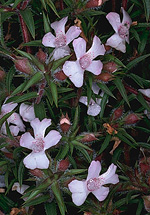 |
This large family occurs almost throughout the world, with centres of diversity around the Mediterranean and in Australia, where they occur in open habitats including forests and woodlands, from the coasts to the arid interior, rarely in closed forests. Many species are introduced and are minor to serious weeds of disturbed places.
Characteristic features of the family Lamiaceae in Australia include: - perennial herbs or shrubs, rarely (Hyptis) small trees.
- leaves simple, opposite or rosetted, usually toothed, borne on usually square stems often with coarse hairs
- flowers usually showy, bisexual, often arranged in clusters along an axis, each cluster subtended by a bract (which may be leaf-like), or in panicles or cymes
- corolla usually white, red or purple, tubular and usually 2-lipped with a lower lobed lip, often with spots or streaks to guide pollinators.
- stamens 2 or 4 in two pairs, enclosed in the corolla or exserted
- ovary superior, often 4-lobed and with a bifid style inserted in a depression between the lobes, separating at maturity into 4 hard, dry nutlets
Description
Evergreen trees, or shrubs, or annual or perennial terrestrial herbs, or rarely aquatic herbs rooted in the substrate with their leaves emergent. Perennating by rhizomes or taproots. Vegetative reproduction absent or by rhizomes or stolons. Stems unarmed or rarely with thorns or spines arising from the leaf axils; nodes conspicuously swollen or not; internodes solid or hollow, terete, oval or slightly flattened or distinctly angular. Internal secretions not obvious or frequently of essential oils. Plants glabrous, or with simple, glandular or non-glandular, uniseriate hairs. Leaves opposite, in whorls of 3–5, or spiral (rarely), cauline or both basal and cauline if herbs, petiolate, subsessile or sessile. Stipules and stipellae absent. Lamina simple, or rarely once compound, paripinnate or imparipinnate, symmetric, pinnatifid, pinnatisect, palmatifid or palmatisect; lamina/leaflets/lobes filiform, acicular, subulate, linear, lanceolate, ovate, elliptic, oblanceolate, ovate, oblong, flabellate or orbicular; base cuneate, attenuate, rounded, cordate, hastate or sagittate or lobed or auriculate; margins entire, crenate, dentate or serrate or sinuate, ±flat, revolute or recurved; one-veined, or the venation pinnate, or palmate, with the midrib conspicuous or inconspicuous, and the tertiary venation reticulate or not; surfaces dark- or pellucid-punctate or not punctate; herbaceous, leathery or succulent; distinctive odour absent, or aromatic, or foetid. Domatia absent or consisting of pits or pockets in the vein angles. All the flowers bisexual, or occurring together with female flowers. Inflorescences terminal or axillary, consisting of capitula, spikes, racemes, cymes, thyrses, verticillasters or solitary flowers, or rarely panicles. Bracts present, though sometimes early deciduous. Bracteoles present or absent. Pollination by insects or rarely birds. Flowers odourless or fragrant, sessile or stalked. Floral disc usually present; nectaries present on the disc. Perianth of 2 dissimilar whorls. Calyx regular or irregular; segments fused, with 2–5 (–10) lobes, imbricate or open in bud; calyx bell-shaped, funnel-shaped or tubular, herbaceous. Corolla irregular; segments fused, with 2–5 petals, alternating with or with no clear relationship to the calyx segments, imbricate in bud; corolla bell-shaped or funnel-shaped, 1 or 2-lipped with or without palate, white, cream, yellow, red, pink, magenta, purple, violet or blue, without contrasting markings, or streaked, spotted, etc, membranous; lobes ±entire, or notched, emarginate, bifid, bilobed, trifid, trilobed or more divided. Fertile stamens 2 or 4, opposite to or not clearly correlated with the calyx lobes, at least partly fused to the perianth, free of the ovary and style, distinct from each other, arranged in 2 unequal pairs or rarely equal pairs. Staminodes present or absent. Anthers dorsifixed, versatile or not versatile, opening inwards by longitudinal slits, 2-celled; appendages absent or rarely basal. Ovary superior, sessile, or often on a swollen stalk. Carpels 2 and fused, or apparently 4 and free from each other; ovary with 2 or 4 (by intrusion of ovary wall) locules. Style gynobasic, single and unbranched, or bifid above, or absent and the stigma ±sessile. Ovules 2 or apparently 1 per locule, sessile; placentation basal or axile. Fruit a dry schizocarpic or rarely indehiscent; a schizocarp forming 4 achene-like mericarps (microbasarium); the perianth on the maturing fruit deciduous, dry and persistent or growing larger. Disseminule macro-surface featureless, carinate or costate; micro-surface ±smooth or reticulate, white, cream, green, brown, grey or black, without contrasting markings, or conspicuously patterned, dull. Seeds 1–4 per fruit. Aril absent. Cotyledons 2. Embryo straight.
(Note: this description has been generated from the coded data compiled for the key. Any errors in the key data will be reflected in the descriptions.)
A treatment of the family Lamiaceae has not yet been published in the Flora of Australia. It will appear in Volume 31.
Australian genera of Lamiaceae (as recognised for the Flora of Australia)
† = some species native, others introduced
* = all species introduced
†Ajuga
Anisomeles
*Ballota
*Basilicum
*Calamintha
*Cedronella
Ceratanthus
*Clinopodium
Coleus
*Dracocephalum
Dysophylla
Eichlerago
Epimeredi
*Glechoma
Hemiandra
Hemigenia
*Hyptis
*Lamium
*Lavandula
*Leonotis
*Leonurus
Leucas
Lycopus
*Marrubium
*Melissa
†Mentha
Microcorys
*Moluccella
*Monarda
Nepeta
†Ocimum
*Origanum
Orthosiphon
Plectranthus
Pogostemon
Prostanthera
†Prunella
Pycnostachys
*Rosmarinus
†Salvia
Scutellaria
*Stachys
Teucrium
*Thymus
Westringia
Wrixonia

|
  |

Ajuga australis (flowers)
Photo: G.Leiper © G.Leiper

Ajuga australis (flowers)
Photo: K.Thiele © K.Thiele

Dysophylla verticillata (flowers)
Photo: M.Fagg © ANBG

Hemiandra pungens (flowers)
Photo: M.Fagg © ANBG

|
 |
|